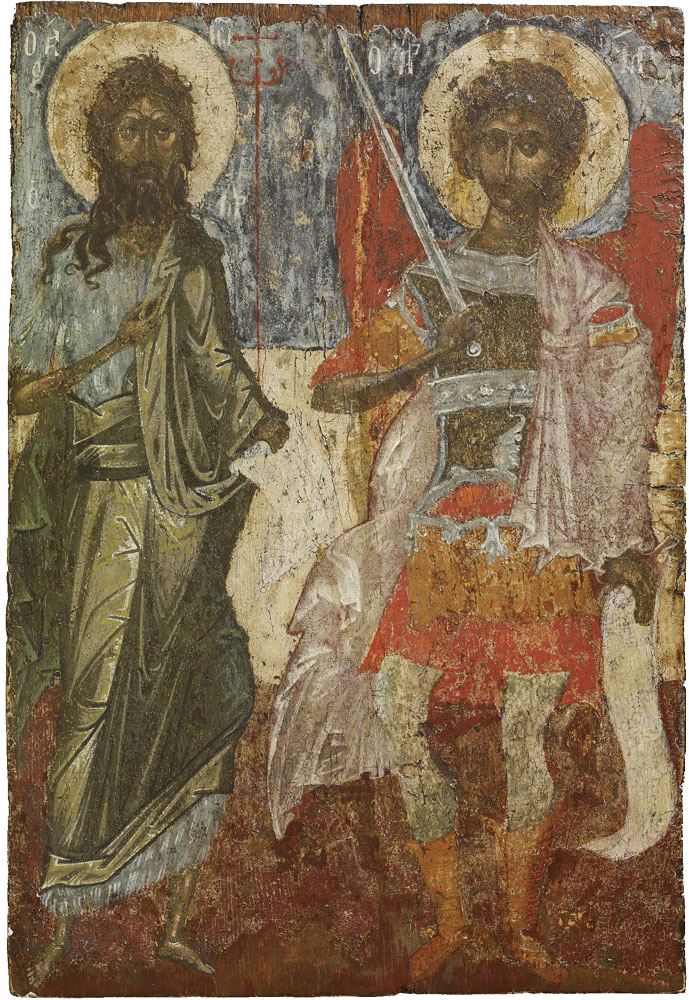The icon is painted in egg tempera on wood primed with gesso over cloth. The back is unpainted and has two eye-hooks for suspension. The two saints are represented full length. On the left St John the Baptist is identified with an abbreviated Greek inscription: O AOC IωΠP (St John the Baptist). He wears a sheepskin under his tunic and holds a staff with a cross at the apex and a scroll. On the right, the Archangel Michael is identified with an inscription: O AΡ MI. He is dressed in a military uniform and holds a sword and a scroll. The panel is generally quite worn, resulting in the loss of the text on the scrolls held by the figures. At some time, the icon has been restored, with some overpainting. Also at some point in its history, the icon was trimmed on the left and right side, possibly in order to fit into a frame. On the reverse is a handwritten blue label belonging to The Temple Gallery which states: ‘St John the Baptist. The Archangel Michael. School of Salonica, 15th century’.
The depiction of the two saints together is not a standard iconographic theme and was perhaps the personal choice of the unknown commissioner. A possible link between St John the Baptist and the Archangel Michael is their representation in compositions of the Last Judgment. St John, traditionally portrayed as the third member of the Deisis scene in the upper part of the Last Judgment, supplicates along with the Virgin to Christ on behalf of the souls of the dead. In the same composition, the Archangel Michael is usually identified with the angel weighing souls on scales. Additionally, since early Christianity St Michael was regarded as the psychopompos, the conductor of souls to the afterworld (Meinardus 1978). An eschatological interpretation of the icon would also be in line with its use as an object of private devotion, which is suggested by its relatively small dimensions.
The three zones of differing colours in the background of full-length depictions of saints are a typical characteristic of icons produced in northern Greece and the wider region of Macedonia as well as central Greece. They are seen for instance in 16th- and 17th-century icons housed at the Byzantine Museum of Kastoria (Kakavas 2004), but also in monumental painting such as the frescoes in the dome of the katholikon of the Stauroniketa Monastery, Mount Athos, painted by Theophanes the Cretan (Chatzidakis 1986) or those from the Petra Monastery in Thessaly (Sdrolia 2012).
Also, the impressive armour of the Archangel Michael with the intricate metal ornaments of the cuirass and the pteryges (a type of skirt made of hanging leather strips) around the groin find parallels in works of northern Greece such as an image of the archangel on a side panel of a 16th-century triptych attributed to a workshop of Mount Athos (Drandaki 2002). Additionally, the distinctive way in which his cloak is tied in a knot on his left shoulder is very similar to frescoes of Kastoria such as the figures of Sts Theodore Teron and Stratelates in the Church of the Holy Apostles tou Georgiou dated to 1547 (Pelekanides 1953). This feature is however more widespread and is also encountered in Cretan works like the 1640 icon of the Archangel Michael painted by George Skordiles (Chatzidakis and Drakopoulou 1997).
The painting of the flesh follows Palaiologan prototypes rendering forms from shadow through the use of light. However, the under paint colours used in this icon are much darker than in Byzantine icons, and this feature is found widely in works of northern Greece; for example, olive brown with lighter expanses of ochre on the prominent features such as forehead, cheekbones, and chin. The fine highlights under the left eye of the archangel are the result of a restoration (an observation made by conservator Lynne Harrison). Generally, the colour range of the icon is rich, employing different shades of green, blue, red and pink. The drapery folds follow the forms of the bodies but they are more rigid when compared to icons of the Byzantine period. These iconographic and stylistic traits would fit an attribution to the early 16th century and to a good northern-Greek icon painter familiar with the Byzantine tradition.
Literature: S. Pelekanides, Καστοριά Ι. Βυζαντιναί Τοιχογραφίαι. Πίνακες, Thessaloniki, 1953, pl. 202; The Temple Gallery, An Exhibition of Icons. Chester – York – Edinburgh – London, July-September 1967, Edinburgh, 1967, cat. no. 55; O. Meinardus, ‘Der Erzengel Michael als Psychopompos’, Orientalia Christiana 62 (1978), 166–8; M. Chatzidakis, Ο κρητικός ζωγράφος Θεοφάνης. Η τελευταία φάση της τέχνης του στις τοιχογραφίες της Ιεράς Μονής Σταυρονικήτα, Mount Athos, 1986, pls 25–6; M. Chatzidakis and E. Drakopoulou, Έλληνες ζωγράφοι μετά την Άλωση (1450-1830), Athens, 1997, 355, fig. 244; A. Drandaki, Greek Icons, 14th -18th Century. The Rena Andreadis Collection, Milan, 2002, no, 40, 178. G. Kakavas, ‘Βυζαντινές και Μεταβυζαντινές εικόνες από την περιοχή της Καστοριάς’, in Θωράκιον. Τόμος στη Μνήμη του Παύλου Λαζαρίδη, Athens, 2004, 335–6, pl. 116 a,b; S. Sdrolia, Οι τοιχογραφίες του καθολικού της Μονής Πέτρας (1625) και η ζωγραφική των Αγράφων του 17ου αιώνα, Volos, 2012, pls 209–12; R. Cormack, Icons, London, 2014 (2nd ed.), no. 101, 138.
Eleni Dimitriadou
